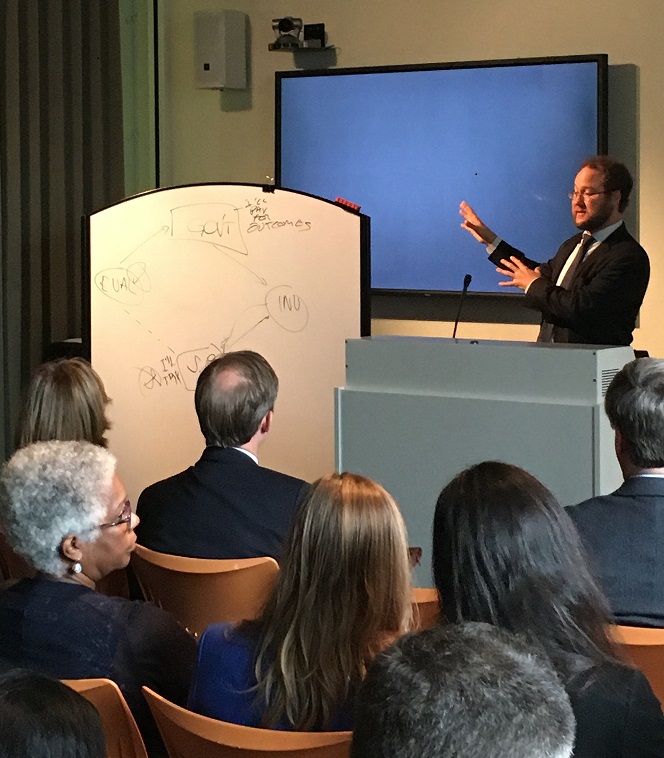
“Since the founding of our country, “home” has been the center of the American dream. Stable housing is the foundation upon which everything else in a family’s or individual’s life is built—without a safe, affordable place to live, it is much tougher to maintain good health, get a good education or reach you full potential.”
-President Barack Obama
Chronic homelessness is one of those challenges that has seemed unsolvable—an unfortunate fact of life, a sad state of affairs, a visible reminder of our limits to help those most in need.
But that view is changing. The evidence shows that new solutions can enable us to end homelessness as we know it. Most notably, permanent supportive housing connects those who are chronically homeless with the housing and support they need to build more stable lives.
What’s more, investing in this solution helps reduce costs to the social safety net system. Those who are chronically homeless are too frequently in need of emergency health services and hospitalization, a challenge and cost-center for the criminal justice system, and in and out of shelters. Robust evidence indicates that when the chronically homeless receive permanent supportive housing, their need for social services plummets, as do the costs associated with those services. In fact, permanent supportive housing can pay for itself, generating more savings than it costs to implement.
“Now is the time to challenge our Nation to aspire to end homelessness…investing in the status quo is no longer acceptable…prevention and innovation must be at the forefront of our efforts.”
-President Barack Obama
Permanent supportive housing is the kind of solution we need. But there is a challenge: too often, governments can’t afford to invest in preventive services because budgets are overstretched paying for safety net costs like emergency rooms and shelters.
Santa Clara County, CA is taking a bold step to address this challenge. Santa Clara is drawing a new bargain – stepping up to pay for permanent supportive housing, doing so with a creative response to common budgetary barriers. The County is committing to pay once the solution has achieved its promise of reducing homelessness, improving lives, and generating savings.
 Today, I am at Google headquarters in Santa Clara for a discussion with leaders in government, philanthropy and technology on how Pay for Success initiatives can communities scale up proven solutions like permanent supportive housing. We’re also discussing how administrative data (hospital admissions, frequency of arrest, etc) can offer faster, more accurate information on outcomes, enabling us to better understand impact.
Today, I am at Google headquarters in Santa Clara for a discussion with leaders in government, philanthropy and technology on how Pay for Success initiatives can communities scale up proven solutions like permanent supportive housing. We’re also discussing how administrative data (hospital admissions, frequency of arrest, etc) can offer faster, more accurate information on outcomes, enabling us to better understand impact.
Pay for Success is a public-private approach to problem solving that enables stakeholders to come together around a common challenge, set measurable goals, and catalyze action. In other words, to do a Pay for Success project, Santa Clara needed others to step up as well. Through Pay for Success, a government lays out a challenge and promises to pay for results achieved. Nonprofit service providers scale up their work to meet the government’s challenge. Often, mission investors provide upfront funding to the nonprofits to undertake the work and are paid back only if positive outcomes are achieved. To scale up permanent supportive housing through Pay for Success, Santa Clara needed a few key partners.
First, the County needed an experienced community organization that could provide the housing and supportive services this population so desperately needs. A local housing services provider for the homeless agreed to work with the County to provide that support.
Second, since Santa Clara will only pay once positive outcomes and savings are achieved, the County also needed someone to cover the provider’s costs of service delivery. They found impact investors willing to take on the risk that the provider will be successful. One investor – Google, a major local employer – is making a no-interest investment through its charitable foundation and return of funding for success will go back to the service provider. All told, philanthropic and charitable supporters including Google.org, The Reinvestment Fund, CSH, Irvine Foundation, The California Endowment and others invested $6.9 million in the success of Santa Clara’s plan.
Third, Santa Clara needed an independent evaluator to rigorously assess whether the program measurably improves clients’ housing stability, health, and social service utilization outcomes and the level of savings for local government. The evaluation will be performed by the University of California, San Francisco. Technology partner, Palantir, is helping make data tracking cheaper and faster so the program can learn quickly and course-correct as needed. Through Pay for Success, the County will only repay investors if the UCSF evaluators find the service improves clients’ housing stability beyond a predetermined level of impact. With those partners in place, Santa Clara recently announced the launch of their Pay for Success project, the nation’s eighth, and the second using the Pay for Success tool, to respond to chronic homelessness. The program will serve up to 200 chronically homeless individuals.
The project is already underway and today the County with several other partners are sharing their experience with the White House. In the heart of Silicon Valley, we are enthusiastic about the ability of this region to pioneer better, faster uses of administrative data to enable lower cost and rapid-cycle evaluation, inform impact, and help service providers learn, course correct, and continuously improve.
Seven similar Pay for Success projects across the country are already enabling local governments to contract for new services and pay for them only if programs actually achieve outcomes—ranging from improving early childhood education to reducing recidivism. Many others are on the way.
The Obama Administration is supporting the growth of Pay for Success as a promising new tool to scale up proven solutions that yield better results. The Social Innovation Fund at the Corporation for National and Community Service is helping communities assess and adopt the solution by supporting new Pay for Success feasibility and project design efforts in 38 communities nation-wide. In addition, the Department of Labor, through the Workforce Innovation Fund, is funding outcomes to increase employment and reduce recidivism among at-risk populations. Other agencies are taking action as well.
And back in Santa Clara, they are not done either. The County is already at work on a second Pay for Success project to improve health outcomes for the County’s mentally ill.


